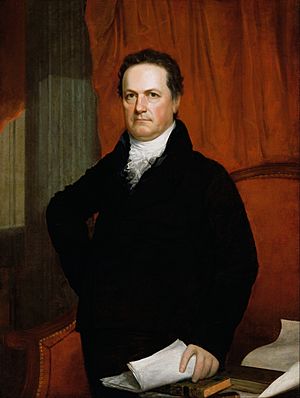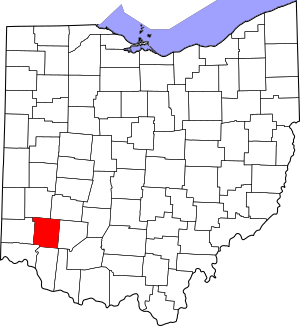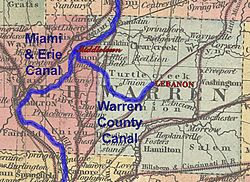Warren County Canal facts for kids
The Warren County Canal was a special waterway in southwestern Ohio. It was a branch of the larger Miami and Erie Canal. This canal was about 20 miles (32 km) long. It connected the town of Lebanon to the main canal at Middletown. This happened in the mid-1800s.
Lebanon was an important town with two main roads. One road went from Cincinnati to Columbus. The other went from Chillicothe to Oxford. But business people in Lebanon wanted even better ways to move goods. They worked hard to get their own canal built. Many people in the early 1800s were excited about canals. However, the Warren County Canal was never very successful. It was used for less than ten years before the state stopped operating it.
Contents
History of the Canal
Building the Canal: A Big Project Begins

The main Miami and Erie Canal was approved in 1825. Work started that same year. By December 1827, boats could travel from the Ohio River in Cincinnati to Middletown. By April 1830, it reached Dayton. The entire canal, all the way to Lake Erie at Toledo, opened in 1845.
DeWitt Clinton, who was the Governor of New York. He was the main person behind New York's famous Erie Canal. He visited Ohio in 1829 for the start of the Miami and Erie Canal. He also visited Lebanon and stayed at the Golden Lamb Inn. The people of Lebanon became very excited about canals. They wanted their own connection to the new waterway. The state quickly agreed to their request.
On February 22, 1830, the Ohio General Assembly created a private company. This company was called the Warren County Canal Company. Its job was to build and run the canal branch to Lebanon. The company thought the canal would cost about $123,861. But the work was very slow. The company eventually realized it could not finish the canal.
So, on February 20, 1836, the General Assembly ordered the state's Canal Commissioners to take over. The state paid the private company half of what it had spent so far, which was $21,742.33. The Commissioners thought it would cost $128,000 to finish the project. But this amount was not enough. The state ended up spending a total of $217,552 to buy and complete the canal.
The Canal Opens for Business

The Warren County Canal was fully ready for boats in 1840. It had reached Lock 2 near Lebanon on March 15, 1839. The canal was 40 feet (12 m) wide. It also had a 10-foot (3 m) wide towpath. This path was for horses or mules to pull the canal boats.
The canal started at Middletown. This spot was between Miami and Erie Locks 31 and 32. The canal got its water from a feeder canal. This feeder was about 3 miles (5 km) north of Middletown. The canal used a lot of water, about 1800 to 2000 cubic feet (51 to 57 cubic meters) per minute.
From Middletown, the canal went southeast. It passed through gentle land with lots of sand and gravel. This land was shaped by glaciers many thousands of years ago. Because of this type of ground, the canal leaked a lot of water.
The canal crossed two aqueducts over Dick's Creek. Aqueducts are like bridges that carry water. These aqueducts were too shallow for heavy boats. The canal then crossed from Butler County into Warren County. This was near the town of Monroe.
The canal continued southeast, following Muddy Creek. Then it turned northeast, next to Turtle Creek. It crossed Turtle Creek on another aqueduct. In Lebanon, there was a special area called a turning basin. This was where boats could turn around. The canal in Lebanon got its water from the North and East Forks of Turtle Creek. A 100-foot (30 m) long earth dam was built on the North Fork. This created a reservoir, a large lake, of about 40 to 45 acres (16 to 18 ha).
Lebanon was 44 feet (13 m) higher than the Miami and Erie Canal at Middletown. To handle this change in height, six locks were needed. Each lock was 90 feet (27 m) long and 15 feet (4.6 m) wide. Locks are like water elevators for boats.
- Lock 1 was in Lebanon.
- Lock 2 was also in Lebanon, a short distance away.
- Lock 3 was about a mile (1.6 km) southwest of Lebanon.
- Lock 4 was about 3 miles (4.8 km) southwest of Lebanon. These first four locks raised and lowered boats a total of 28 feet (8.5 m).
- Lock 5 was near where the feeder canal from the Miami and Erie Canal entered.
- Lock 6 was at Middletown, where the canal joined the Miami and Erie Canal. These last two locks raised and lowered boats the remaining 16 feet (4.9 m), 8 feet (2.4 m) by each lock.
The Canal's End: Shaker Run Causes Trouble
In 1848, a stream called Shaker Run caused serious damage to the canal. Shaker Run was in western Turtlecreek Township. It drained a large swamp from the Shaker community at Union Village. This stream often overflowed its banks. When it flooded, it filled the canal with mud and dirt. This meant constant cleaning and repairs were needed. Finally, Shaker Run broke through the canal's side wall.
In 1852, an engineer named John W. Erwin looked into repairing the canal. He was asked by the General Assembly to estimate the cost. They also wanted to know if the canal should just be given up. He reported that it would cost $31,613 to fix the Warren County Canal. A big part of that, $16,896, was just for cleaning out the mud.
Because the canal had not been used much, the state decided not to repair it. In 1854, the state sold what was left of the canal for $40,000 to John W. Corwin and R.H. Henderson.
The large stones from the canal's locks were used in local buildings. Many were used in the Lebanon Opera House. This building later burned down on Christmas Day, 1932. Other stones were used in a bridge over the North Fork. The reservoir on the North Fork of Turtle Creek broke during a big rainstorm on July 10, 1882. This caused a lot of damage in Lebanon. The land where the reservoir was is now Colonial Park.
Today, very little of the canal remains. You can still see a few ditches along State Route 63 in Turtlecreek Township.
Images for kids
See also
 In Spanish: Canal del condado de Warren para niños
In Spanish: Canal del condado de Warren para niños



